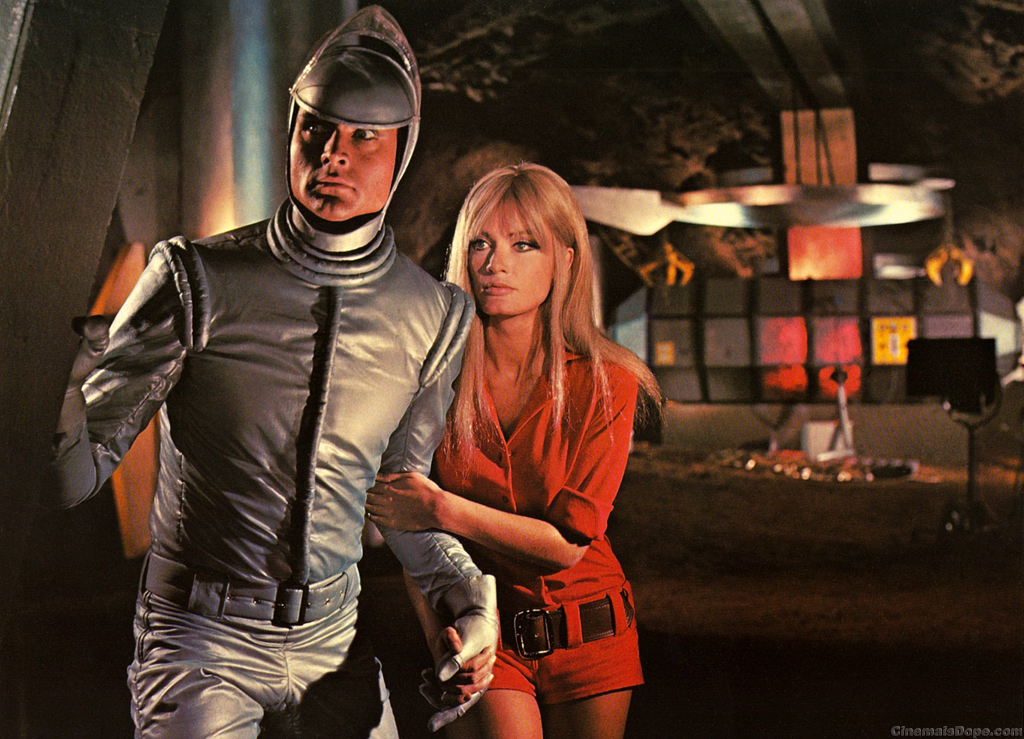 European Enigmas European Enigmas
Eurospy films is a nickname for the genre of European international co-production films that imitated and spoofed the James Bond 007 series of films. Bond-mania had swept through Europe -- even though the character of Bond hated everyone on that continent who wasn't English. Each country developed their own 007, with varying results. For example Jesus Franco's or "Jess Frank"'s 1964 La Muerte Silba un Blues was later retitled 077 OPERATION JAMAICA or 077 OPERATION SEXY with star Conrado San Martín rechristened "Sean Martin" to evoke images of Sean Connery and Dean Martin. Meanwhile, Switzerland's THE UNKNOWN MAN OF SHANDIGOR/L'INCONNU DE SHANDIGOR (1967) features a mad scientist, who discovers a method of neutralizing atomic weapons. This marks him out for particular attention from Russian and American secret agents. He also has a strange pet, a sea monster, which he keeps in a pool. The latter conveniently eats the villain, thereby relieving the Bond-like hero of responsibility for making the world safe for democracy.

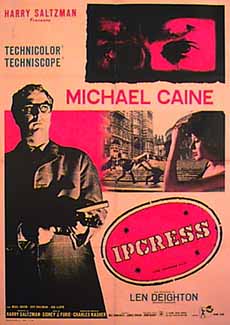 Hairy Palms, get it? Hairy Palms, get it?
The Ipcress File
The most successful non-Bond spy films of the time were the "Harry Palmer" films starring Michael Caine, based on a series of Len Deighton books with an unnamed title character, and produced by Harry Salzman of EON. The first was THE IPCRESS FILE (1965), then FUNERAL IN BERLIN (1966), BILLION DOLLAR BRAIN (1967), BULLET TO BEIJING (1995) and MIDNIGHT IN SAINT PETERSBURG (1995), the last two being shot back-to-back. The IPCRESS File novel came out just after the release of the first James Bond film Dr. No (1962). When the novel sold well, Eon producers Harry Saltzman and Albert Broccoli approached Deighton to write the script for the next 007 film, From Russia With Love (1963); despite Deighton's efforts, little of his screenplay was filmed. Saltzman instead decided to use The IPCRESS File and its sequels as the beginning of a new secret agent movie series. Unlike the Bond films, The IPCRESS File was designed to have a different, more down-beat style, although Saltzman employed many Bond movie staff, including production designer Ken Adam, editor Peter Hunt, and composer John Barry. Michael Caine was chosen to play the lead.
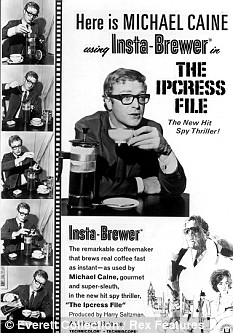 Vodka martinis? Bollinger champagne? Vodka martinis? Bollinger champagne?
How about just a good cup of coffee?
When developing THE IPCRESS FILE, the production team needed a name for the previously anonymous secret agent protagonist, they chose "Harry Palmer", because they wanted a dull, unglamorous name to distance him from Ian Fleming's James Bond, the stereotypical flamboyant, swashbuckling spy (ironic, since that was Fleming's strategy when he named the character of 007). In his memoirs, Michael Caine says producer Harry Saltzman thought up the surname "Palmer", and Caine innocently remarked that "Harry" was a dull name, not realising his gaffe until seeing Saltzman's stare. In a Len Feldman interview, Caine recalled "I made a rather bad social blunder, because, he said, 'What's the dullest name you can think of ?', and I said, 'Harry', and he said, 'Thanks very much.' And then he said, 'What's a dull surname ?', and the most boring boy in our school was called: 'Palmer', 'Tommy Palmer'. So, he said, 'All right, we'll call him Harry Palmer.'" Caine played Harry Palmer in three films based on the four published novels featuring this character, and also later in two films not based on Len Deighton's novels. Another, SPY STORY (1976) starred Michael Petrovitch, with the character renamed 'Patrick Armstrong'.

 Artwork by that man from the Bond posters, Frank McCarthy Artwork by that man from the Bond posters, Frank McCarthy
for That Man from Rio
"THAT MAN FROM RIO" (1964) (French: "L'HOMME DE RIO") was a French-Italian international co-production directed by Philippe de Broca and the first film to be made by the French subsidiary of Bond's distributors, United Artists (called Les Productions Artistes Associés).
This adventure film starring Jean-Paul Belmondo and Françoise Dorléac was a follow-up to "CARTOUCHE," a popular historical swashbuckler film also starring Belmondo, but it was decided that as he should next star in a James Bond spoof. The story was inspired by a series of comic albums called The Adventures of Tintin. Italian financing of the film even led to the casting of "THUNDERBALL" bad guy Adolfo Celi in the film. Belmondo went on to appear in the 1967 Bond spoof, "CASINO ROYALE."
"THAT MAN FROM RIO" was a huge success internationally, and was even nominated for Best Original Screenplay at the 37th Academy Awards. It was also one of the main inspirations for "RAIDERS OF THE LOST ARK" (1981) -- Steven Spielberg himself reportedly told de Broca that he'd seen it nine times! Spielberg then went on to produce and direct "THE ADVENTURES OF TINTIN," a computer-animated action-adventure film, in 2011.

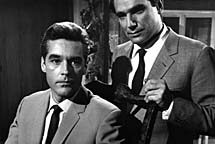 Cherchez la femme: the second of three entries in the French secret agent Cherchez la femme: the second of three entries in the French secret agent
OSS 117's series, Shadow of Evil
A French series of James Bond rip-offs, the three OSS 117 films of the 1960's featured three different stars as the titular secret agent -- Frederick Stafford (costar of TOPAZ), Kerwin Matthews and John Gavin (who almost became Bond in DIAMONDS ARE FOREVER, until Connery finally signed on at the last moment). OSS 117 -- MISSION FOR A KILLER/FURIA A BAHIA POUR OSS 117 (1966), SHADOW OF EVIL/BANCO A BANGKOK POUR OSS 117 (1967) and NO ROSES FOR OSS 117/PAS DE ROSES POUR OSS 117 (1968) were stripped-down pictures that lacked the gadgetry and gloss of the Bond films.
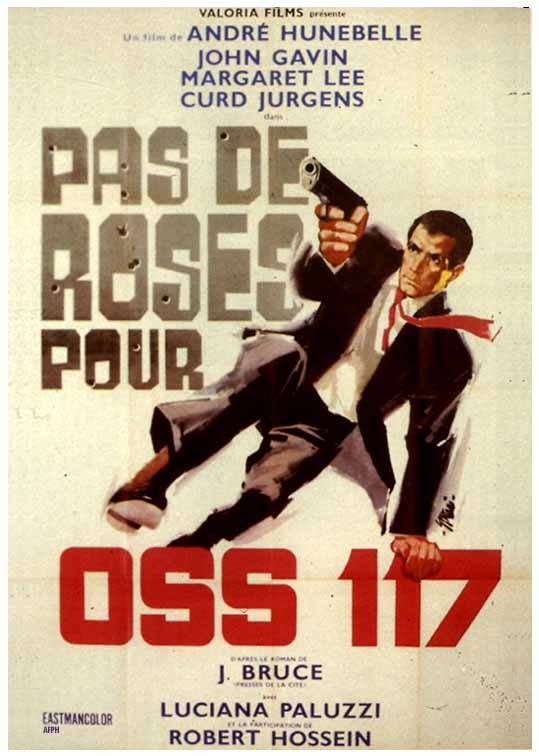 The change in actors was easily explained. For the Gavin film (NO ROSES, also called DOUBLE AGENT), OSS 117 had his face surgically altered to look like a notorious killer, and was then arrested by the police. Soon a secret crime organization busted him out of jail and offered him a job to make an important killing. Gavin starred in the film with former Bond Bad girl Luciana Paluzzi (THUNDERBALL) future Bond baddie Curt Jurgens (THE SPY WHO LOVED ME). The change in actors was easily explained. For the Gavin film (NO ROSES, also called DOUBLE AGENT), OSS 117 had his face surgically altered to look like a notorious killer, and was then arrested by the police. Soon a secret crime organization busted him out of jail and offered him a job to make an important killing. Gavin starred in the film with former Bond Bad girl Luciana Paluzzi (THUNDERBALL) future Bond baddie Curt Jurgens (THE SPY WHO LOVED ME).
In 2006, a new OSS 117 was introduced, starring Jean Dujardin as the now-oafish spy Hubert Bonisseur de la Bath (pictured below). In a period piece as indebted to Austin Powers as it is to Bond, Special Agent OSS 117 pops up in Cairo, 1955, to monitor the Suez Canal, check up on the Brits and Soviets, burnish France's reputation, quell a fundamentalist rebellion and broker peace in the Middle East. "No problem," replies Hubert Bonisseur de la Bath - ala Maxwell Smart.
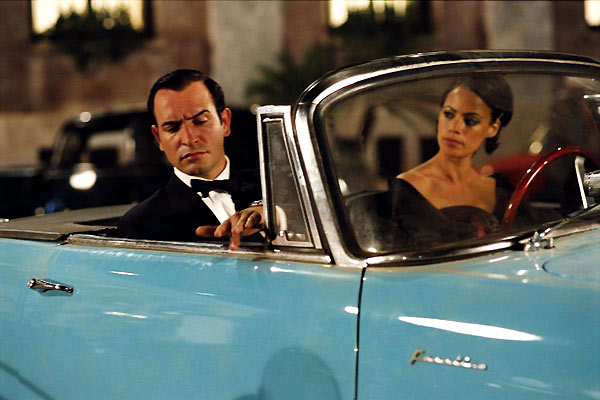
OSS 117: LOST IN RIO, in the original French OSS 117: RIO NE RÉPOND PLUS (2009) directed by Michel Hazanavicius, follows the exploits of OSS 117 in Brazil over a decade later, in 1967. The film opens and closes with Dean Martin songs, uses set furniture inspired by Dean Martin's Matt Helm films, and reuses footage from FURIA À BAHIA POUR OSS 117 (OSS 117: Mission for a Killer) (1965).


 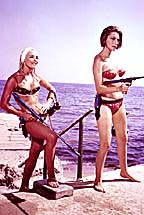 Guns 'n' poses: Guns 'n' poses:
Deadlier Than the Male and way ahead of Baywatch, Elke Sommer and Sylva Koscina strut their stuff.
In Britain, Bondmania inspired a revival of amateur sleuth Hugh "Bulldog" Drummond, athletic hero of a series of detective novels by Sapper and Hugh McNeile and a score of detective movies released during the '30s and '40s. The new, modernized Drummond (Richard Johnson) was given an 007-style makeover, pitted against international supervillains, surrounded by '60s Euro-babes, and... wait for it... made an insurance investigator. Cooooooool!!!
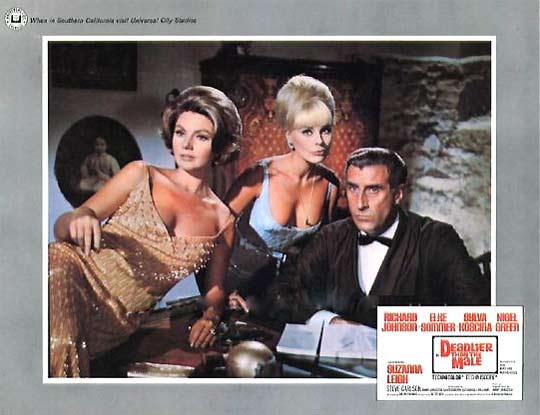 The first of these updates, entitled DEADLIER THAN THE MALE (1967), is a reference to the 1911 Rudyard Kipling poem "The Female of the Species," which includes the line: "The female of the species must be deadlier than the male", and also refers to Sapper's earlier Drummond book "The Female of the Species". The first of these updates, entitled DEADLIER THAN THE MALE (1967), is a reference to the 1911 Rudyard Kipling poem "The Female of the Species," which includes the line: "The female of the species must be deadlier than the male", and also refers to Sapper's earlier Drummond book "The Female of the Species".
In the story, a millionaire oil executive is murdered on his private jet plane by a stewardess using a bullet-firing cigar. She then sets up a bomb and skydives out the door, as the evidence explodes behind her.
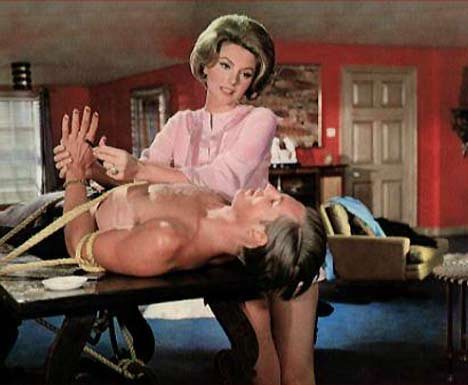 Then, with an accomplice, the same woman shoots a businessman at his home by the sea. This woman is Miss Eckman (Elke Sommer), her partner in crime is Penelope (Sylva Koscina), and they're working for a mysterious mastermind who is trying to take over the oil industry. Insurance underwriter Hugh "Bulldog" Drummond (Richard Johnson, who was once up for the role of Bond) is brought in to investigate the suspicious deaths, and it's not long before he is caught up in an international conspiracy, with his own life at stake. (I never knew insurance investigators lived in luxury, ate the best caviar and drank the best wines -- no wonder my premiums are so high!!!) Unlike the Bond films, there's no main, romantic subplot. The attitude to sex can be summed up by the shot of Drummond's nephew Robert (who's American to appeal to the transatlantic audiences) apparently lying under an amorous Koscina, only for the camera to pull back to reveal that he's tied up and she's torturing him. Then, with an accomplice, the same woman shoots a businessman at his home by the sea. This woman is Miss Eckman (Elke Sommer), her partner in crime is Penelope (Sylva Koscina), and they're working for a mysterious mastermind who is trying to take over the oil industry. Insurance underwriter Hugh "Bulldog" Drummond (Richard Johnson, who was once up for the role of Bond) is brought in to investigate the suspicious deaths, and it's not long before he is caught up in an international conspiracy, with his own life at stake. (I never knew insurance investigators lived in luxury, ate the best caviar and drank the best wines -- no wonder my premiums are so high!!!) Unlike the Bond films, there's no main, romantic subplot. The attitude to sex can be summed up by the shot of Drummond's nephew Robert (who's American to appeal to the transatlantic audiences) apparently lying under an amorous Koscina, only for the camera to pull back to reveal that he's tied up and she's torturing him.
 This was followecd by SOME GIRLS DO (1968), which replicated the earlier film's formula of having Drummond's nemesis backed up by two sexy villainesses. This time round, the bad girls were Baroness Helga, played by Daliah Lavi, and Pandora, played by Beba Loncar. Sydne Rome provided back-up for Drummond as a sexy hanger-on named Flicky. This was followecd by SOME GIRLS DO (1968), which replicated the earlier film's formula of having Drummond's nemesis backed up by two sexy villainesses. This time round, the bad girls were Baroness Helga, played by Daliah Lavi, and Pandora, played by Beba Loncar. Sydne Rome provided back-up for Drummond as a sexy hanger-on named Flicky.
Drummond is hired after a series of inexplainable accidents befall the people and companies who are responsible for developing the world's first supersonic airliner, the SST1. Drummond, with the help of Flicky, uncovers a plot by a mastermind named Carl Petersen, who stands to gain eight million pounds if the aircraft is not ready by a certain date. Petersen has developed a number of robots: beautiful girls with electronic brains to help him sabotage the SST1 project by means of infrasound (sound waves with too low frequency to be detected by the human ear) which can be directed at people or objects with devastating results. Bond girl Joanna Lumley (ON HER MAJETY'S SECRET SERVICE) appears as one of Petersen's female robots.

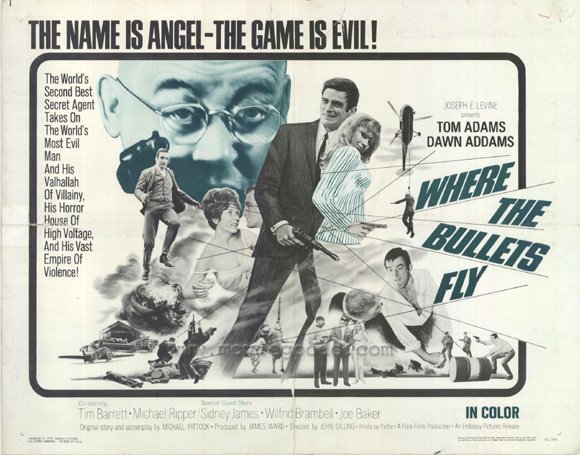
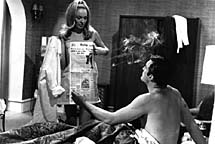 Second-rate spy Tom Adams gets first-class room service in Second-rate spy Tom Adams gets first-class room service in
Where the Bullets Fly.
LICENSED TO KILL (1963, Lindsay Shonteff) and WHERE THE BULLETS FLY (1966, John Gilling) introduced Tom Adams -- whose greatest asset is a conspicuous resemblance to Sean Connery -- as a bumbling secret agent Charles Vine, who is "first in his class in weapons and unarmed combat and took a first at Oxford in Maths." To help explain the lower budget and gadgets, Vine reports to "Rockwell" (John Arnatt), an "M" who has to keep his office warm with an electric heater and lamenting that H.M. Government spends more on toilet paper rolls to troops than his entire department.
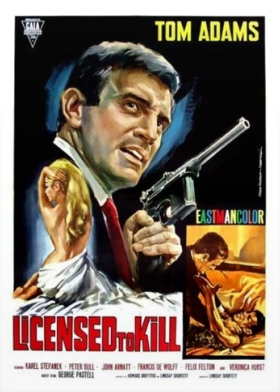 LICENSED TO KILL was directed and co-written by Lindsay Shonteff, who has Vine foil assassination attempts by a transvestite named She He, and a master assassin named Sadistikov. LICENSED TO KILL was directed and co-written by Lindsay Shonteff, who has Vine foil assassination attempts by a transvestite named She He, and a master assassin named Sadistikov.
Producer Joseph E. Levine picked it up for American and worldwide distribution and reedited it under the title THE SECOND BEST SECRET AGENT IN THE WHOLE WIDE WORLD. The American release eliminated scenes of Francis de Wolff talking to John Arnatt about seeking Bond for the assignment, first. He also gave it a seriously swinging theme song, performed by Sammy Davis Jr. Nobody cared, The theme song for the American version, composed by Sammy Cahn and James Van Heusen and performed by Sammy Davis, Jr., but it was used in the 2011 film drama TINKER TAILER SOLDIER SPY. The American publicity campaign for the James Bond exploitation film echoed the 'Number 2, but tries harder' advertising of the Avis Rent a Car System prevalent at the time.
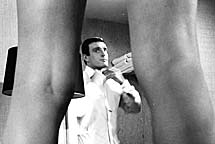 Knee-high to The Second Best Secret Agent Knee-high to The Second Best Secret Agent
in the Whole Wide World
Shonteff was missing from the two Vine sequels starring Tom Adams: WHEN BULLETS FLY (1966) (directed by Warwick Films and Hammer Films director John Gilling) that was also released by Embassy Films, and SOMEBODY'S STOLEN OUR RUSSIAN SPY/O.K. YEVTUSHENKO (1969), a film shot in Spain instead of the usual UK location, that languished in a film laboratory until 1976
 Shonteff later made three spy films with the hero named "Charles Bind," perhaps to avoid rights difficulties with LTK producer James Ward, starting with NUMBER ONE OF THE SECRET SERVICE (1970) starring a fair haired Roger Moore imitator named Nicky Henson, originally titled 008 OF THE SECRET SERVICE. Bind now battles an organization named K.R.A.S.H. (Killing Rape Arson Slaughter and Hit). Okay, I get the killing, arson and hits, but are rape and slaughter good tentpoles for a business model? Shonteff later made three spy films with the hero named "Charles Bind," perhaps to avoid rights difficulties with LTK producer James Ward, starting with NUMBER ONE OF THE SECRET SERVICE (1970) starring a fair haired Roger Moore imitator named Nicky Henson, originally titled 008 OF THE SECRET SERVICE. Bind now battles an organization named K.R.A.S.H. (Killing Rape Arson Slaughter and Hit). Okay, I get the killing, arson and hits, but are rape and slaughter good tentpoles for a business model?
With the publicity battle between the rival James Bonds of Albert R. Broccoli's THE SPY WHO LOVED ME and Kevin McClory's projected WARHEAD in 1976, Shonteff returned to the secret agent fold with Bind in LICENSED TO LOVE AND KILL (1979) with Gareth Hunt as Bind when Henson was busy with the Royal Shakespeare Company. The film retitled THE MAN FROM S.E.X. and featured Carlotta Muff-Dangerfield ("Lotta Muff"), an ambitious American Senator named Lucifer Orchid (obviously couldn't use SPECTER), and Bind's counterpart in the forces of evil, Ultra One.
Next came Michael Howe as Bind in NUMBER ONE GUN (1990).

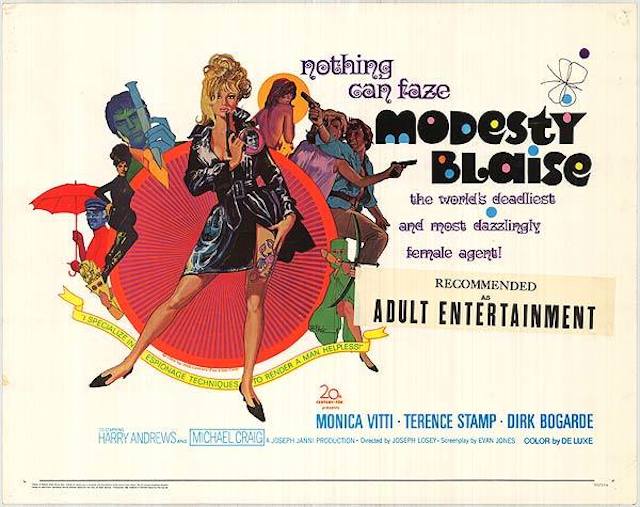
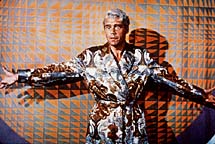 Dyed-in-the-wool villain: Dirk Bogarde Dyed-in-the-wool villain: Dirk Bogarde
in Modesty Blaise...
Dirk Bogarde, as malevolent aesthete Gabriel, is the highlight of Joseph Losey's MODESTY BLAISE (1966), though most people watch it for Monica Vitti as sexy superspy Modesty -- Bond with breasts.
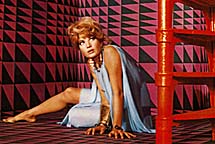 Modesty prevails? Monica Vitti as a distaff James Bond Modesty prevails? Monica Vitti as a distaff James Bond
The film's Swinging London ambience is now so far out that it's in again: Note the cover of the book John Travolta is seen reading in PULP FICTION. (Quentin Tarantino eventually produced a remake.)

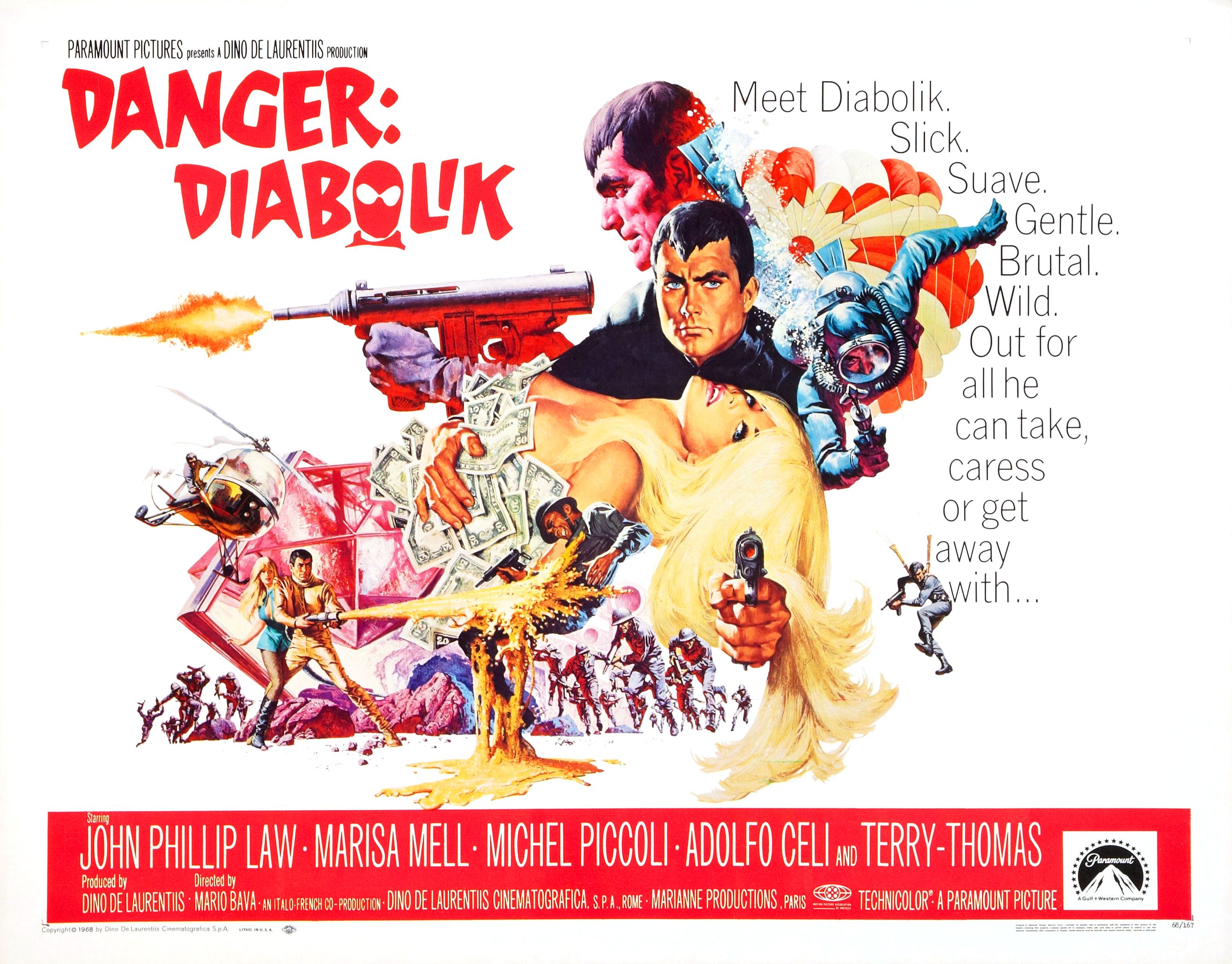
 Supervillain Diabolik (John Phillip Law) Supervillain Diabolik (John Phillip Law)
and his lovely associate prefer cash to bonds.
Bava also directed cult favorite DANGER: DIABOLIK (1967), which shifts the focus entirely to a leather-clad master criminal (John Phillip Law) of exquisite depravity. He's eventually turned into a golden statue by some thoroughly uninteresting do-gooder. The direct descendant of Fantomas, favorite of surrealists everywhere, Diabolik's high-tech lair and futuristic gadgetry nevertheless owe a great deal to Bond. The music by Ennio Morricone is fantastic, as well -- especially main theme, "Deep Deep Down."

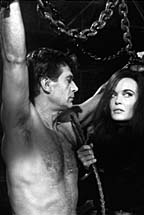 Ah, the joys of Bondage: Ah, the joys of Bondage:
The Million Eyes of Su-Muru
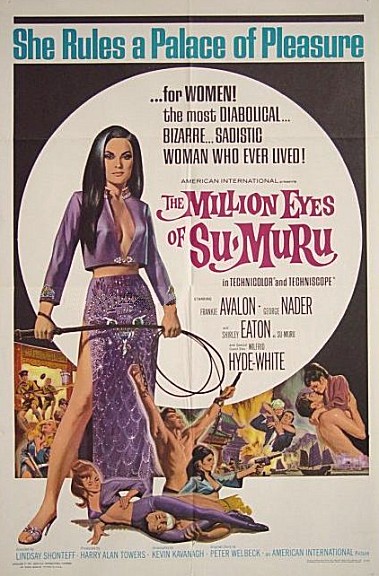 Returning to the suspiciously popular theme of lethal ladies, consider THE MILLION EYES OF SU-MURU (1967). It has a very impressive list of AKAs, THE 1000 EYES OF SU-MURU, SLAVE GIRLS OF SU-MURU, and for Mystery Science Theater 3000 fans, 'EPISODE K18'. In THE MILLION EYES, Shirley Eaton -- GOLDFINGER's gilded corpse -- plays Oriental villainess Su-Muru, a distaff Fu Manchu (also created by novelist Sax Rohmer) who plans to enslave the world with her army of women. Secret agents Frankie Avalon and George Nader have to stop her. In the German-made sequel RIO 70/DIE SIBEN MANNER DER SU-MARU (1970), directed by Spanish exploitation legend Jess (Jesus) Franco, Eaton returns as Su-Maru and tries again, while Avalon and Nader are nowhere to be found. Like the DR. GOLDFOOT movies, the SU-MURU (or MARU) films are informed by a profound anxiety about what women get up to when there are no men around to keep them in their place. Returning to the suspiciously popular theme of lethal ladies, consider THE MILLION EYES OF SU-MURU (1967). It has a very impressive list of AKAs, THE 1000 EYES OF SU-MURU, SLAVE GIRLS OF SU-MURU, and for Mystery Science Theater 3000 fans, 'EPISODE K18'. In THE MILLION EYES, Shirley Eaton -- GOLDFINGER's gilded corpse -- plays Oriental villainess Su-Muru, a distaff Fu Manchu (also created by novelist Sax Rohmer) who plans to enslave the world with her army of women. Secret agents Frankie Avalon and George Nader have to stop her. In the German-made sequel RIO 70/DIE SIBEN MANNER DER SU-MARU (1970), directed by Spanish exploitation legend Jess (Jesus) Franco, Eaton returns as Su-Maru and tries again, while Avalon and Nader are nowhere to be found. Like the DR. GOLDFOOT movies, the SU-MURU (or MARU) films are informed by a profound anxiety about what women get up to when there are no men around to keep them in their place.
"What kind of Space Age sorceress are you?" the hero asks super-villain Shirley Eaton at one point in this ludicrous film.
A rather lame one, I can attest. Not only does her plan for world domination make no sense, but her army of machinegun-toting, go-go booted Amazons doesn't even have any bullets — the gals just shake their weapons at the camera while gunfire crackles on the soundtrack. Some of 'em don't even have ammo clips!
The Girl from Rio is yet another late '60s collaboration of director Jess Franco and producer Harry Allan Towers, the team responsible for such poverty row pulp fictions as The Blood of Fu Manchu and The Castle of Fu Manchu. Towers, using his "Peter Welbeck" alias, also wrote the script, so it is he who must shoulder most of the blame for what ended up on screen. Though Franco does what he can to imbue it with a pop art/comic book sensibility and a breezy attitude, the film is severely undercut by its miserly budget and a choppy screenplay rife with bad dialog.
Mysterious — and badly dressed — playboy type Jeff Sutton (Richard Wyler) arrives in Rio and checks in to a hotel. According to underworld rumors Sutton is believed to be carrying $10 Million in stolen cash. This draws the interest of a big-shot local mobster, Mr. Masius (Hollywood veteran George Sanders, in one of his last roles). Sutton supposedly stole the money in America but the nature of the theft is never explained; all we need to know is that Masius really wants to get his hands on it. So he sends various henchmen against Sutton, who continually defeats them with the hideousness of his plaid sports jacket. (Actually he uses poorly staged judo moves and karate chops to best the baddies. Franco isn't exactly known as an action director.)
In between dodging Masius' thugs Sutton takes up with the hotel's hot-to-trot manicurist, Leslie (Maria Rohm in a horrid black wig), who's very easy to get in the sack. She's really an agent of Sumitra (Goldfinger's Shirley Eaton), an evil female genius who plans to take over the world with an army of women she's building at a secret base called Femina in the Brazilian jungle. Leslie's job is to lure our hero to Femina so that his purloined millions can be added to Sumitra's coffers. (World domination naturally requires regular infusions of capital.) Sutton, however, isn't who he seems to be either. No thief, he's actually a mercenary hired to rescue a kidnapped heiress from Sumitra's clutches. The $10 Million is phony. It's merely bait to attract Sumitra's operatives, so that he can learn where her headquarters is located. But drawing the attention of mob boss Masius wasn't part of the plan...
Set to a lively samba-flavored lounge score by Daniel White, The Girl from Rio blithely bounces along from one ridiculous set-piece to the next, rarely making any sense, until it finally self-destructs (as Sumitra's base is supposed to do) in the disastrously botched finale. As the hero, Wyler is a complete dud (that jacket has got to go!), punching a lot more air than henchmen. All the film's action scenes are pathetic. Other shots are clumsily recycled to bridge scenes or pad out the running time. (Perhaps explaining some of Sumitra's "instant" dye jobs... For some inexplicable reason her hair color changes from brunette to blonde and back again from scene to scene.) Eaton obviously relished the chance to play a "dragon lady" and is fine in the Sumitra role, but how she could recite some of that dialog with a straight face is beyond me. The secondary villain, Masius, is the sort of ruthless gangster who wears polka-dot cravats, uses a pink telephone (with a 90-foot cord) and deplores the sight of blood. (While his thugs torture the captured Leslie for information, he lies on a sofa chuckling over a Popeye comic book.) Sanders, perhaps a trifle embarrassed to be participating, at least gets to snuggle up to shapely Elisa Montés, whose comic performance as Masius' sexy "accountant" is one of the film's high points.
So the movie's not a complete waste. Any flick this dumb is going to have a few unintentional laughs. (Behold the foxy heiress being tortured with a plastic electric fan! And there's that silly gun-shaking business to simulate actually firing them. Blanks cost money, ya know!) Shot on location in Rio De Janeiro, Franco takes good advantage of the scenery and local color. He could've made a great documentary just on the Carnivale. (Instead he made this film and 99 Women, starring Herbert Lom and Rosalba Neri, at the same time!) Maria Rohm (Justine, The Bloody Judge) shows us a bit of skin, too.
NOTE: Though based on pulp writer Sax Rohmer's Sumuru character, Eaton's female Blofeld is listed as "Sumitra" in the closing credits but referred to as "Sunanda" by everyone in the film. What the —???
It almost goes without saying that The Girl from Rio receives first-class treatment by Blue Underground. The print used for this transfer, anamorphically letterboxed at 1.66:1, looks remarkably good. (Only a tiny bit of damage is fleetingly glimpsed.) Colors are especially vibrant — the ladies' outfits and costumes of the Carnivale revelers showcase a kaleidoscope of different hues. As for audio quality, the disc's digital mono track is clean and clear. White's enjoyable score isn't compromised.
Extras: a poster/still gallery, a talent bio of Jess Franco (the same as featured on the other BU Franco titles), a step-through essay on Rohmer's Sumuru novels (illustrated with pulp paperback covers), and a 14-minute documentary, Rolling in Rio, with director Franco, writer/producer Towers and star Shirley Eaton participating. Deft editing incorporates scenes from the film with salient and amusing anecdotes in the interview segments. BU has a track record of producing terrific featurettes (for their own label and others); the one included with The Girl from Rio aka Future Woman (1969) is no exception. 2/16/04 http://www.njedge.net/~knapp/sumuru.htm
  OUR MAN IN MARRAKESH (released in North America as Bang! Bang! You're Dead!) is a 1966 British comedy spy film directed by Don Sharp and starring Tony Randall, Herbert Lom and Senta Berger. One of six travellers who catch the bus from Casablanca airport to Marrakesh is carrying $2 million to pay a powerful local man (Herbert Lom) to fix United Nations votes on behalf of an unnamed nation. But not even the powerful man knows which of them it is - and his background checks reveal that at least three of them aren't who they claim to be. As agents from other nations may be among them, he and his henchmen have to be very careful until the courier chooses to reveal himself - or herself... Our Man in Marrakesh opened in London on 5 May 1966, the same day as A Man Could Get Killed and the day before Modesty Blaise. This caused the critic in The Times to write a combined review titled "Humorous variations on theme of the secret agent", where Our Man in Marrakesh is noted for having a similar story as A Man Could Get Killed, but lacking the former's wit. However, the film gets some credit for a literally colourful chase through Marrakesh's dyers' quarter." In November 1964, she guest starred in an episode of the U.S. television show, The Man from U.N.C.L.E, entitled "The Double Affair". It was later expanded and released in cinemas as the feature film The Spy with My Face (1965). In 1967, Berger acted in the pilot film for the Robert Wagner television series It Takes a Thief, which aired on American television network ABC on 9 January 1968. She reprised her role in the series in October 1969, in an episode in which her character was killed off. One shot from the film seems to have heavily inspired EON for their film, For Your Eyes Only: OUR MAN IN MARRAKESH (released in North America as Bang! Bang! You're Dead!) is a 1966 British comedy spy film directed by Don Sharp and starring Tony Randall, Herbert Lom and Senta Berger. One of six travellers who catch the bus from Casablanca airport to Marrakesh is carrying $2 million to pay a powerful local man (Herbert Lom) to fix United Nations votes on behalf of an unnamed nation. But not even the powerful man knows which of them it is - and his background checks reveal that at least three of them aren't who they claim to be. As agents from other nations may be among them, he and his henchmen have to be very careful until the courier chooses to reveal himself - or herself... Our Man in Marrakesh opened in London on 5 May 1966, the same day as A Man Could Get Killed and the day before Modesty Blaise. This caused the critic in The Times to write a combined review titled "Humorous variations on theme of the secret agent", where Our Man in Marrakesh is noted for having a similar story as A Man Could Get Killed, but lacking the former's wit. However, the film gets some credit for a literally colourful chase through Marrakesh's dyers' quarter." In November 1964, she guest starred in an episode of the U.S. television show, The Man from U.N.C.L.E, entitled "The Double Affair". It was later expanded and released in cinemas as the feature film The Spy with My Face (1965). In 1967, Berger acted in the pilot film for the Robert Wagner television series It Takes a Thief, which aired on American television network ABC on 9 January 1968. She reprised her role in the series in October 1969, in an episode in which her character was killed off. One shot from the film seems to have heavily inspired EON for their film, For Your Eyes Only:
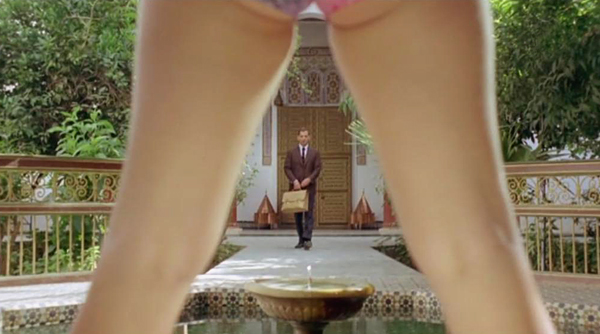
 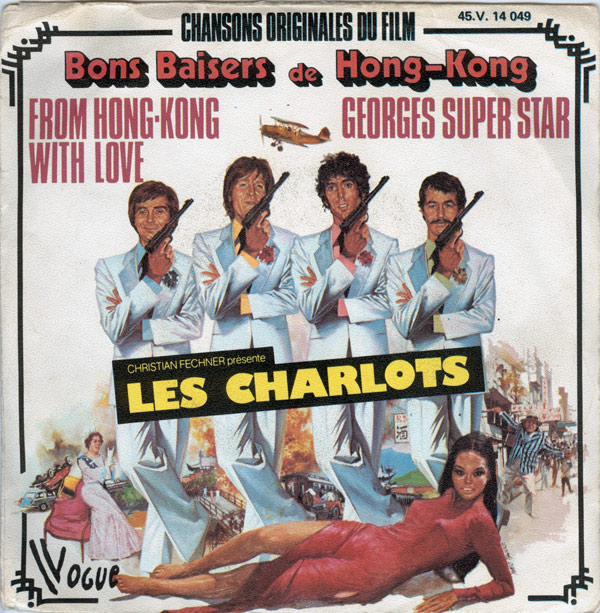 FROM HONG KONG WITH LOVE (1975). Starring: Lois Maxwell, Bernard Lee, and Clifton James. James Bond dies in the opening, and Her Majesty's Secret Service must replace him. Despite being an obscure parody, the film features many legitimate Bond film actors. Originally released as Bons baisers de Hong Kong. It's a 1975 French film directed by Yvan Chiffre. It is a parody of James Bond movies featuring Les Charlots with scenes shot in Hong Kong. Mickey Rooney featured in the film as well as Bernard Lee and Lois Maxwell, stars of the James Bond films who appeared as M and Moneypenny respectively. It was filmed at the Shaw Brothers studios in Hong Kong. FROM HONG KONG WITH LOVE (1975). Starring: Lois Maxwell, Bernard Lee, and Clifton James. James Bond dies in the opening, and Her Majesty's Secret Service must replace him. Despite being an obscure parody, the film features many legitimate Bond film actors. Originally released as Bons baisers de Hong Kong. It's a 1975 French film directed by Yvan Chiffre. It is a parody of James Bond movies featuring Les Charlots with scenes shot in Hong Kong. Mickey Rooney featured in the film as well as Bernard Lee and Lois Maxwell, stars of the James Bond films who appeared as M and Moneypenny respectively. It was filmed at the Shaw Brothers studios in Hong Kong.

MORE EUROTRASH:
Le Tigre aime la chair fraiche (1964), Le Tigre se parfume à la dynamite (1965), and Blue Panther, aka Marie Chantal contre Dr. (1965), French trilogy directed by Claude Chabrol.
008: Operation Exterminate (1965), featuring a female 007 type agent. Directed by Umberto Lenzi.
Agent 077: Mission Bloody Mary and Agent 077 From the Orient with Fury (both 1965), Italian Eurospy adventures starring Ken Clark.
Licensed to Kill (1965), low budget series featuring Agent Charles Vine, later Charles Bind, is more imitative than satirical.
Voitheia! O Vengos faneros praktor 000 which can be translated in English: Help! Vengos apparent agent 000 (1967) and a sequel Thou-Vou falakros praktor, epiheirisis "Yis Mathiam" which can be translated in English: Thou-Vou bald agent, operation "Havoc" (1969). Thanasis Veggos (Thou-Vou) stars in both.
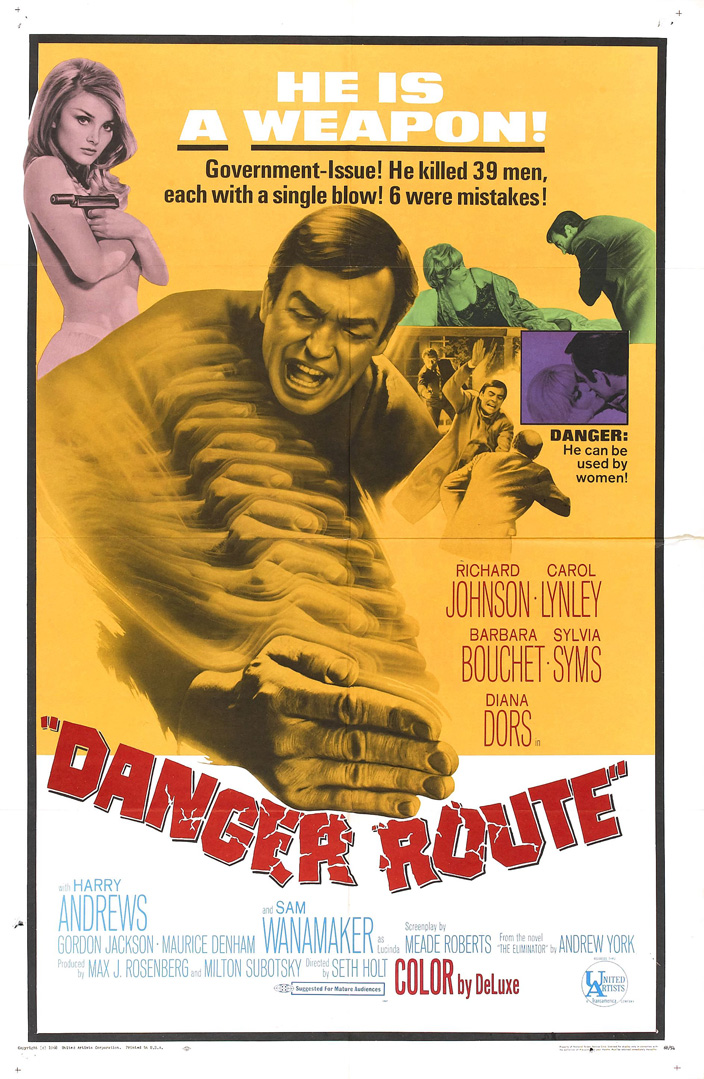 Danger Route (1967), in which Jonas Wilde, a British secret service agent licensed to kill, returns from a successful mission determined to resign. Canning, his London superior, agrees to forward his resignation if Wilde eliminates a Czechoslovakian scientist defector now being held by the Americans. With the help of a housekeeper, Rhoda Gooderich, Wilde kills the scientist but is himself captured and interrogated by CIA agent Lucinda. After Lucinda tells Wilde that someone in his organization is causing fellow British agents to be killed by mistake, Wilde escapes to look for Canning, who mysteriously has disappeared. Accompanied by Canning's wife, Barbara, Wilde heads for the leader's base in the Channel Islands. Director: Seth Holt; Stars: Richard Johnson, Carol Lynley, Barbara Bouchet.
Zeta One (1969), a British sexploitation Spy-fi with Robin Hawdon as James Word, a womanizing secret agent who investigates James Robertson Justice's criminal mastermind at the behest of 'W' and discovers a race of barely-clad alien superwoman called Angvians. Co-starring Carry On... veteran Charles Hawtrey and Dawn Addams (star of Star Maidens and occasional leading lady in Roger Moore's The Saint) as Zeta.
The Black Windmill (1974) is a British spy thriller directed by Don Siegel and starring Michael Caine, John Vernon, Janet Suzman and Donald Pleasence. It was produced by Richard D. Zanuck and David Brown. The screenplay by Leigh Vance is based on Clive Egleton's novel "Seven Days to a Killing." The story involves a British secret service agent, John Tarrant (Caine), involved in the investigation of an international arms syndicate. Tarrant's son is kidnapped and held to ransom, leading Tarrant to discover that he cannot even rely on the people on his own side.
Never Say Never Mind: The Swedish Bikini Team (2001) British straight-to-video spoof, featuring a team of beautiful women as the Bondian heroines.
Allkopi Royale (2006), a short Bond Spoof starring Thomas Milligan and Quantum for Allkopi (2008), a Sequel to Allkopi Royale, featuring Norwegian celebrities such as Linni Meister, Helge Hammelow-Berg and Martin Garfalk. Danger Route (1967), in which Jonas Wilde, a British secret service agent licensed to kill, returns from a successful mission determined to resign. Canning, his London superior, agrees to forward his resignation if Wilde eliminates a Czechoslovakian scientist defector now being held by the Americans. With the help of a housekeeper, Rhoda Gooderich, Wilde kills the scientist but is himself captured and interrogated by CIA agent Lucinda. After Lucinda tells Wilde that someone in his organization is causing fellow British agents to be killed by mistake, Wilde escapes to look for Canning, who mysteriously has disappeared. Accompanied by Canning's wife, Barbara, Wilde heads for the leader's base in the Channel Islands. Director: Seth Holt; Stars: Richard Johnson, Carol Lynley, Barbara Bouchet.
Zeta One (1969), a British sexploitation Spy-fi with Robin Hawdon as James Word, a womanizing secret agent who investigates James Robertson Justice's criminal mastermind at the behest of 'W' and discovers a race of barely-clad alien superwoman called Angvians. Co-starring Carry On... veteran Charles Hawtrey and Dawn Addams (star of Star Maidens and occasional leading lady in Roger Moore's The Saint) as Zeta.
The Black Windmill (1974) is a British spy thriller directed by Don Siegel and starring Michael Caine, John Vernon, Janet Suzman and Donald Pleasence. It was produced by Richard D. Zanuck and David Brown. The screenplay by Leigh Vance is based on Clive Egleton's novel "Seven Days to a Killing." The story involves a British secret service agent, John Tarrant (Caine), involved in the investigation of an international arms syndicate. Tarrant's son is kidnapped and held to ransom, leading Tarrant to discover that he cannot even rely on the people on his own side.
Never Say Never Mind: The Swedish Bikini Team (2001) British straight-to-video spoof, featuring a team of beautiful women as the Bondian heroines.
Allkopi Royale (2006), a short Bond Spoof starring Thomas Milligan and Quantum for Allkopi (2008), a Sequel to Allkopi Royale, featuring Norwegian celebrities such as Linni Meister, Helge Hammelow-Berg and Martin Garfalk.
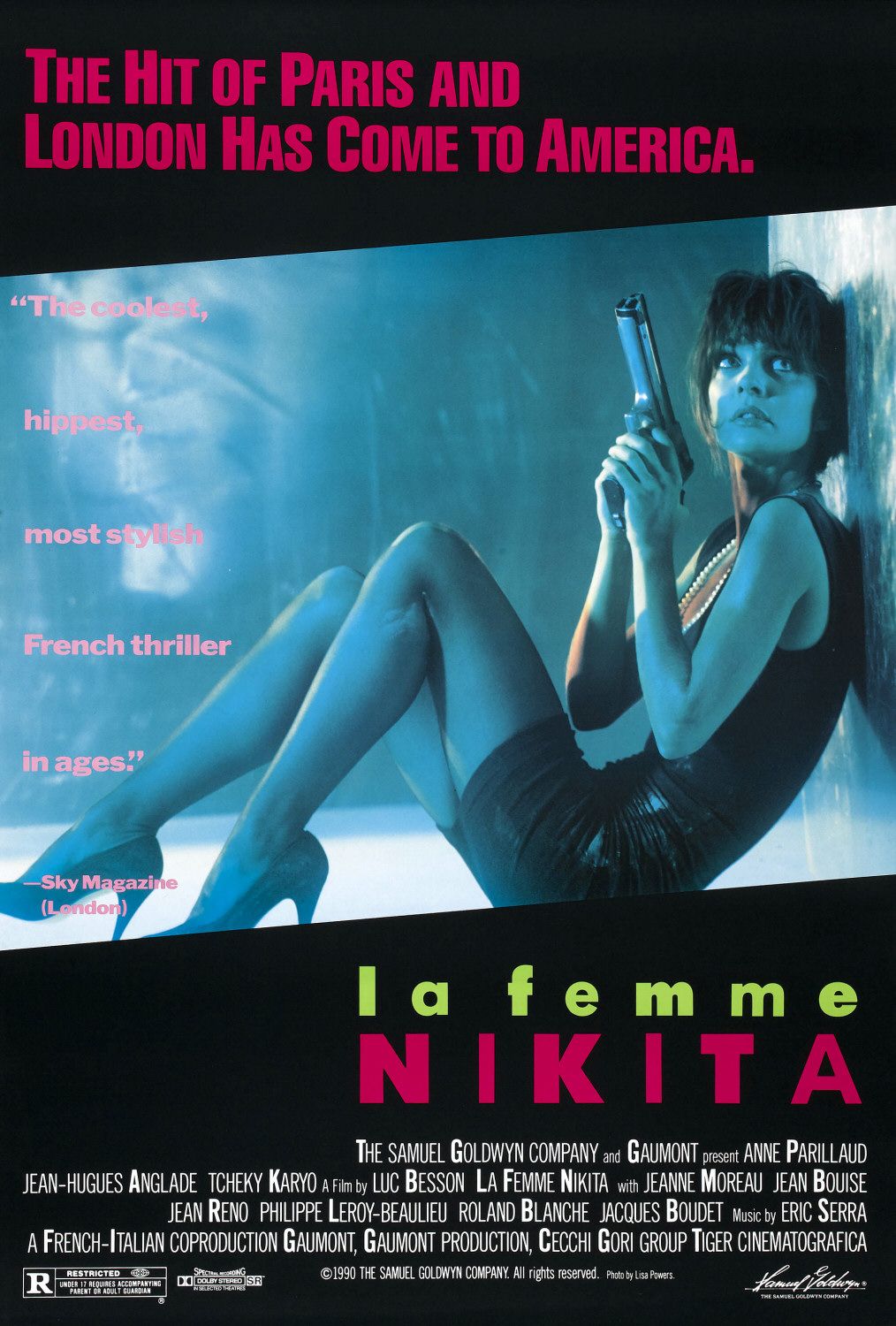 La Femme Nikita (1990), is a Franco-Italian action thriller film in which convicted cop killer Nikita, instead of being put to death by lethal injection, is given a new identity and trained as a top secret spy/assassin. (118 mins.)
Director: Luc Besson; Stars: Anne Parillaud, Marc Duret, Patrick Fontana, Alain Lathière. Remade in US as Point of No Return (1993), in which hardened criminal Maggie Hayward's consistent violence, even in police custody, ends in the execution chamber... (109 mins.)
Director: John Badham; Stars: Bridget Fonda, Gabriel Byrne, Dermot Mulroney, Miguel Ferrer. It also inspired the 1991 Hong Kong action film Black Cat, which closely follows the original film’s storyline. Nikita was then remade as a TV series from 1997 to 2001, with Peta Wilson as the title character. The television series differs from the film versions in one fundamental aspect: Nikita is innocent. She is not a killer, nor a drug user, just a homeless young woman in the wrong place at the wrong time. In 2010, the CW network picked up a new series, Nikita, with Maggie Q as a the title character, who has gone rogue. It ran from September 9, 2010 to December 27, 2013 in the United States. La Femme Nikita (1990), is a Franco-Italian action thriller film in which convicted cop killer Nikita, instead of being put to death by lethal injection, is given a new identity and trained as a top secret spy/assassin. (118 mins.)
Director: Luc Besson; Stars: Anne Parillaud, Marc Duret, Patrick Fontana, Alain Lathière. Remade in US as Point of No Return (1993), in which hardened criminal Maggie Hayward's consistent violence, even in police custody, ends in the execution chamber... (109 mins.)
Director: John Badham; Stars: Bridget Fonda, Gabriel Byrne, Dermot Mulroney, Miguel Ferrer. It also inspired the 1991 Hong Kong action film Black Cat, which closely follows the original film’s storyline. Nikita was then remade as a TV series from 1997 to 2001, with Peta Wilson as the title character. The television series differs from the film versions in one fundamental aspect: Nikita is innocent. She is not a killer, nor a drug user, just a homeless young woman in the wrong place at the wrong time. In 2010, the CW network picked up a new series, Nikita, with Maggie Q as a the title character, who has gone rogue. It ran from September 9, 2010 to December 27, 2013 in the United States.
Studio Portraits || European Enigmas || Italian Jobs || Kovert Komedy || Hong Kong Humint || 00-XXX || More
Photo credits (top to bottom): The Kobal Collection, Everett Collection, Photofest, Everett Collection, Photofest, Everett Collection
Music: "Oss 117 Theme (Remix)", written by Ludovic Bource, performed by Le Metropole Orkest
|
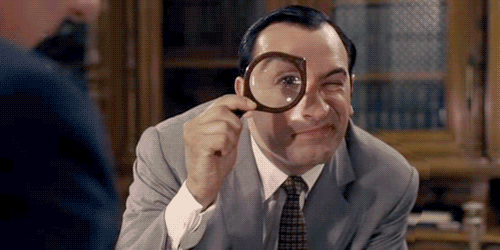

 European Enigmas
European Enigmas
 Hairy Palms, get it?
Hairy Palms, get it? Vodka martinis? Bollinger champagne?
Vodka martinis? Bollinger champagne? Artwork by that man from the Bond posters, Frank McCarthy
Artwork by that man from the Bond posters, Frank McCarthy Cherchez la femme: the second of three entries in the French secret agent
Cherchez la femme: the second of three entries in the French secret agent The change in actors was easily explained. For the Gavin film (NO ROSES, also called DOUBLE AGENT), OSS 117 had his face surgically altered to look like a notorious killer, and was then arrested by the police. Soon a secret crime organization busted him out of jail and offered him a job to make an important killing. Gavin starred in the film with former Bond Bad girl Luciana Paluzzi (THUNDERBALL) future Bond baddie Curt Jurgens (THE SPY WHO LOVED ME).
The change in actors was easily explained. For the Gavin film (NO ROSES, also called DOUBLE AGENT), OSS 117 had his face surgically altered to look like a notorious killer, and was then arrested by the police. Soon a secret crime organization busted him out of jail and offered him a job to make an important killing. Gavin starred in the film with former Bond Bad girl Luciana Paluzzi (THUNDERBALL) future Bond baddie Curt Jurgens (THE SPY WHO LOVED ME).


 Guns 'n' poses:
Guns 'n' poses: The first of these updates, entitled DEADLIER THAN THE MALE (1967), is a reference to the 1911 Rudyard Kipling poem "The Female of the Species," which includes the line: "The female of the species must be deadlier than the male", and also refers to Sapper's earlier Drummond book "The Female of the Species".
The first of these updates, entitled DEADLIER THAN THE MALE (1967), is a reference to the 1911 Rudyard Kipling poem "The Female of the Species," which includes the line: "The female of the species must be deadlier than the male", and also refers to Sapper's earlier Drummond book "The Female of the Species".  Then, with an accomplice, the same woman shoots a businessman at his home by the sea. This woman is Miss Eckman (Elke Sommer), her partner in crime is Penelope (Sylva Koscina), and they're working for a mysterious mastermind who is trying to take over the oil industry. Insurance underwriter Hugh "Bulldog" Drummond (Richard Johnson, who was once up for the role of Bond) is brought in to investigate the suspicious deaths, and it's not long before he is caught up in an international conspiracy, with his own life at stake. (I never knew insurance investigators lived in luxury, ate the best caviar and drank the best wines -- no wonder my premiums are so high!!!) Unlike the Bond films, there's no main, romantic subplot. The attitude to sex can be summed up by the shot of Drummond's nephew Robert (who's American to appeal to the transatlantic audiences) apparently lying under an amorous Koscina, only for the camera to pull back to reveal that he's tied up and she's torturing him.
Then, with an accomplice, the same woman shoots a businessman at his home by the sea. This woman is Miss Eckman (Elke Sommer), her partner in crime is Penelope (Sylva Koscina), and they're working for a mysterious mastermind who is trying to take over the oil industry. Insurance underwriter Hugh "Bulldog" Drummond (Richard Johnson, who was once up for the role of Bond) is brought in to investigate the suspicious deaths, and it's not long before he is caught up in an international conspiracy, with his own life at stake. (I never knew insurance investigators lived in luxury, ate the best caviar and drank the best wines -- no wonder my premiums are so high!!!) Unlike the Bond films, there's no main, romantic subplot. The attitude to sex can be summed up by the shot of Drummond's nephew Robert (who's American to appeal to the transatlantic audiences) apparently lying under an amorous Koscina, only for the camera to pull back to reveal that he's tied up and she's torturing him.  This was followecd by SOME GIRLS DO (1968), which replicated the earlier film's formula of having Drummond's nemesis backed up by two sexy villainesses. This time round, the bad girls were Baroness Helga, played by Daliah Lavi, and Pandora, played by Beba Loncar. Sydne Rome provided back-up for Drummond as a sexy hanger-on named Flicky.
This was followecd by SOME GIRLS DO (1968), which replicated the earlier film's formula of having Drummond's nemesis backed up by two sexy villainesses. This time round, the bad girls were Baroness Helga, played by Daliah Lavi, and Pandora, played by Beba Loncar. Sydne Rome provided back-up for Drummond as a sexy hanger-on named Flicky. 
 Second-rate spy Tom Adams gets first-class room service in
Second-rate spy Tom Adams gets first-class room service in  LICENSED TO KILL was directed and co-written by Lindsay Shonteff, who has Vine foil assassination attempts by a transvestite named She He, and a master assassin named Sadistikov.
LICENSED TO KILL was directed and co-written by Lindsay Shonteff, who has Vine foil assassination attempts by a transvestite named She He, and a master assassin named Sadistikov. Knee-high to The Second Best Secret Agent
Knee-high to The Second Best Secret Agent Shonteff later made three spy films with the hero named "Charles Bind," perhaps to avoid rights difficulties with LTK producer James Ward, starting with NUMBER ONE OF THE SECRET SERVICE (1970) starring a fair haired Roger Moore imitator named Nicky Henson, originally titled 008 OF THE SECRET SERVICE. Bind now battles an organization named K.R.A.S.H. (Killing Rape Arson Slaughter and Hit). Okay, I get the killing, arson and hits, but are rape and slaughter good tentpoles for a business model?
Shonteff later made three spy films with the hero named "Charles Bind," perhaps to avoid rights difficulties with LTK producer James Ward, starting with NUMBER ONE OF THE SECRET SERVICE (1970) starring a fair haired Roger Moore imitator named Nicky Henson, originally titled 008 OF THE SECRET SERVICE. Bind now battles an organization named K.R.A.S.H. (Killing Rape Arson Slaughter and Hit). Okay, I get the killing, arson and hits, but are rape and slaughter good tentpoles for a business model?
 Dyed-in-the-wool villain: Dirk Bogarde
Dyed-in-the-wool villain: Dirk Bogarde Modesty prevails? Monica Vitti as a distaff James Bond
Modesty prevails? Monica Vitti as a distaff James Bond 
 Supervillain Diabolik (John Phillip Law)
Supervillain Diabolik (John Phillip Law)  Ah, the joys of Bondage:
Ah, the joys of Bondage: Returning to the suspiciously popular theme of lethal ladies, consider THE MILLION EYES OF SU-MURU (1967). It has a very impressive list of AKAs, THE 1000 EYES OF SU-MURU, SLAVE GIRLS OF SU-MURU, and for Mystery Science Theater 3000 fans, 'EPISODE K18'. In THE MILLION EYES, Shirley Eaton -- GOLDFINGER's gilded corpse -- plays Oriental villainess Su-Muru, a distaff Fu Manchu (also created by novelist Sax Rohmer) who plans to enslave the world with her army of women. Secret agents Frankie Avalon and George Nader have to stop her. In the German-made sequel RIO 70/DIE SIBEN MANNER DER SU-MARU (1970), directed by Spanish exploitation legend Jess (Jesus) Franco, Eaton returns as Su-Maru and tries again, while Avalon and Nader are nowhere to be found. Like the DR. GOLDFOOT movies, the SU-MURU (or MARU) films are informed by a profound anxiety about what women get up to when there are no men around to keep them in their place.
Returning to the suspiciously popular theme of lethal ladies, consider THE MILLION EYES OF SU-MURU (1967). It has a very impressive list of AKAs, THE 1000 EYES OF SU-MURU, SLAVE GIRLS OF SU-MURU, and for Mystery Science Theater 3000 fans, 'EPISODE K18'. In THE MILLION EYES, Shirley Eaton -- GOLDFINGER's gilded corpse -- plays Oriental villainess Su-Muru, a distaff Fu Manchu (also created by novelist Sax Rohmer) who plans to enslave the world with her army of women. Secret agents Frankie Avalon and George Nader have to stop her. In the German-made sequel RIO 70/DIE SIBEN MANNER DER SU-MARU (1970), directed by Spanish exploitation legend Jess (Jesus) Franco, Eaton returns as Su-Maru and tries again, while Avalon and Nader are nowhere to be found. Like the DR. GOLDFOOT movies, the SU-MURU (or MARU) films are informed by a profound anxiety about what women get up to when there are no men around to keep them in their place. OUR MAN IN MARRAKESH (released in North America as Bang! Bang! You're Dead!) is a 1966 British comedy spy film directed by Don Sharp and starring Tony Randall, Herbert Lom and Senta Berger. One of six travellers who catch the bus from Casablanca airport to Marrakesh is carrying $2 million to pay a powerful local man (Herbert Lom) to fix United Nations votes on behalf of an unnamed nation. But not even the powerful man knows which of them it is - and his background checks reveal that at least three of them aren't who they claim to be. As agents from other nations may be among them, he and his henchmen have to be very careful until the courier chooses to reveal himself - or herself... Our Man in Marrakesh opened in London on 5 May 1966, the same day as A Man Could Get Killed and the day before Modesty Blaise. This caused the critic in The Times to write a combined review titled "Humorous variations on theme of the secret agent", where Our Man in Marrakesh is noted for having a similar story as A Man Could Get Killed, but lacking the former's wit. However, the film gets some credit for a literally colourful chase through Marrakesh's dyers' quarter." In November 1964, she guest starred in an episode of the U.S. television show, The Man from U.N.C.L.E, entitled "The Double Affair". It was later expanded and released in cinemas as the feature film The Spy with My Face (1965). In 1967, Berger acted in the pilot film for the Robert Wagner television series It Takes a Thief, which aired on American television network ABC on 9 January 1968. She reprised her role in the series in October 1969, in an episode in which her character was killed off. One shot from the film seems to have heavily inspired EON for their film, For Your Eyes Only:
OUR MAN IN MARRAKESH (released in North America as Bang! Bang! You're Dead!) is a 1966 British comedy spy film directed by Don Sharp and starring Tony Randall, Herbert Lom and Senta Berger. One of six travellers who catch the bus from Casablanca airport to Marrakesh is carrying $2 million to pay a powerful local man (Herbert Lom) to fix United Nations votes on behalf of an unnamed nation. But not even the powerful man knows which of them it is - and his background checks reveal that at least three of them aren't who they claim to be. As agents from other nations may be among them, he and his henchmen have to be very careful until the courier chooses to reveal himself - or herself... Our Man in Marrakesh opened in London on 5 May 1966, the same day as A Man Could Get Killed and the day before Modesty Blaise. This caused the critic in The Times to write a combined review titled "Humorous variations on theme of the secret agent", where Our Man in Marrakesh is noted for having a similar story as A Man Could Get Killed, but lacking the former's wit. However, the film gets some credit for a literally colourful chase through Marrakesh's dyers' quarter." In November 1964, she guest starred in an episode of the U.S. television show, The Man from U.N.C.L.E, entitled "The Double Affair". It was later expanded and released in cinemas as the feature film The Spy with My Face (1965). In 1967, Berger acted in the pilot film for the Robert Wagner television series It Takes a Thief, which aired on American television network ABC on 9 January 1968. She reprised her role in the series in October 1969, in an episode in which her character was killed off. One shot from the film seems to have heavily inspired EON for their film, For Your Eyes Only:
 FROM HONG KONG WITH LOVE (1975). Starring: Lois Maxwell, Bernard Lee, and Clifton James. James Bond dies in the opening, and Her Majesty's Secret Service must replace him. Despite being an obscure parody, the film features many legitimate Bond film actors. Originally released as Bons baisers de Hong Kong. It's a 1975 French film directed by Yvan Chiffre. It is a parody of James Bond movies featuring Les Charlots with scenes shot in Hong Kong. Mickey Rooney featured in the film as well as Bernard Lee and Lois Maxwell, stars of the James Bond films who appeared as M and Moneypenny respectively. It was filmed at the Shaw Brothers studios in Hong Kong.
FROM HONG KONG WITH LOVE (1975). Starring: Lois Maxwell, Bernard Lee, and Clifton James. James Bond dies in the opening, and Her Majesty's Secret Service must replace him. Despite being an obscure parody, the film features many legitimate Bond film actors. Originally released as Bons baisers de Hong Kong. It's a 1975 French film directed by Yvan Chiffre. It is a parody of James Bond movies featuring Les Charlots with scenes shot in Hong Kong. Mickey Rooney featured in the film as well as Bernard Lee and Lois Maxwell, stars of the James Bond films who appeared as M and Moneypenny respectively. It was filmed at the Shaw Brothers studios in Hong Kong.
 Danger Route (1967), in which Jonas Wilde, a British secret service agent licensed to kill, returns from a successful mission determined to resign. Canning, his London superior, agrees to forward his resignation if Wilde eliminates a Czechoslovakian scientist defector now being held by the Americans. With the help of a housekeeper, Rhoda Gooderich, Wilde kills the scientist but is himself captured and interrogated by CIA agent Lucinda. After Lucinda tells Wilde that someone in his organization is causing fellow British agents to be killed by mistake, Wilde escapes to look for Canning, who mysteriously has disappeared. Accompanied by Canning's wife, Barbara, Wilde heads for the leader's base in the Channel Islands. Director: Seth Holt; Stars: Richard Johnson, Carol Lynley, Barbara Bouchet.
Danger Route (1967), in which Jonas Wilde, a British secret service agent licensed to kill, returns from a successful mission determined to resign. Canning, his London superior, agrees to forward his resignation if Wilde eliminates a Czechoslovakian scientist defector now being held by the Americans. With the help of a housekeeper, Rhoda Gooderich, Wilde kills the scientist but is himself captured and interrogated by CIA agent Lucinda. After Lucinda tells Wilde that someone in his organization is causing fellow British agents to be killed by mistake, Wilde escapes to look for Canning, who mysteriously has disappeared. Accompanied by Canning's wife, Barbara, Wilde heads for the leader's base in the Channel Islands. Director: Seth Holt; Stars: Richard Johnson, Carol Lynley, Barbara Bouchet. La Femme Nikita (1990), is a Franco-Italian action thriller film in which convicted cop killer Nikita, instead of being put to death by lethal injection, is given a new identity and trained as a top secret spy/assassin. (118 mins.)
Director: Luc Besson; Stars: Anne Parillaud, Marc Duret, Patrick Fontana, Alain Lathière. Remade in US as Point of No Return (1993), in which hardened criminal Maggie Hayward's consistent violence, even in police custody, ends in the execution chamber... (109 mins.)
Director: John Badham; Stars: Bridget Fonda, Gabriel Byrne, Dermot Mulroney, Miguel Ferrer. It also inspired the 1991 Hong Kong action film Black Cat, which closely follows the original film’s storyline. Nikita was then remade as a TV series from 1997 to 2001, with Peta Wilson as the title character. The television series differs from the film versions in one fundamental aspect: Nikita is innocent. She is not a killer, nor a drug user, just a homeless young woman in the wrong place at the wrong time. In 2010, the CW network picked up a new series, Nikita, with Maggie Q as a the title character, who has gone rogue. It ran from September 9, 2010 to December 27, 2013 in the United States.
La Femme Nikita (1990), is a Franco-Italian action thriller film in which convicted cop killer Nikita, instead of being put to death by lethal injection, is given a new identity and trained as a top secret spy/assassin. (118 mins.)
Director: Luc Besson; Stars: Anne Parillaud, Marc Duret, Patrick Fontana, Alain Lathière. Remade in US as Point of No Return (1993), in which hardened criminal Maggie Hayward's consistent violence, even in police custody, ends in the execution chamber... (109 mins.)
Director: John Badham; Stars: Bridget Fonda, Gabriel Byrne, Dermot Mulroney, Miguel Ferrer. It also inspired the 1991 Hong Kong action film Black Cat, which closely follows the original film’s storyline. Nikita was then remade as a TV series from 1997 to 2001, with Peta Wilson as the title character. The television series differs from the film versions in one fundamental aspect: Nikita is innocent. She is not a killer, nor a drug user, just a homeless young woman in the wrong place at the wrong time. In 2010, the CW network picked up a new series, Nikita, with Maggie Q as a the title character, who has gone rogue. It ran from September 9, 2010 to December 27, 2013 in the United States.